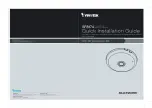
Notes
PES12T3G2 User Manual
1
January 28, 2013
®
About This Manual
Introduction
This user manual includes hardware and software information on the 89HPES12T3G2, a member of
IDT’s PRECISE™ family of PCI Express® switching solutions offering the next-generation I/O interconnect
standard.
Finding Additional Information
Information not included in this manual such as mechanicals, package pin-outs, and electrical character-
istics can be found in the data sheet for this device, which is available from the IDT website (www.idt.com)
as well as through your local IDT sales representative.
Content Summary
Chapter 1, “PES12T3G2 Device Overview,” provides a complete introduction to the performance
capabilities of the 89HPES12T3G2. Included in this chapter is a summary of features for the device as well
as a system block diagram and pin description.
Chapter 2, “Clocking, Reset, and Initialization,” provides a description of the two differential refer-
ence clock inputs that are used internally to generate all of the clocks required by the internal switch logic
and the SerDes.
Chapter 3, “Link Operation,” describes the operation of the link feature including polarity inversion,
link width negotiation, and lane reversal.
Chapter 4, “General Purpose I/O,” describes how the 9 General Purpose I/O (GPIO) pins may be indi-
vidually configured as general purpose inputs, general purpose outputs, or alternate functions.
Chapter 5, “SMBus Interfaces,” describes the operation of the 2 SMBus interfaces on the
PES12T3G2.
Chapter 6, “Power Management,” describes the power management capability structure located in the
configuration space of each PCI-PCI bridge in the PES12T3G2.
Chapter 7, “Hot-Plug and Hot-Swap,” describes the behavior of the hot-plug and hot-swap features in
the PES12T3G2.
Chapter 8, “Configuration Registers,” discusses the base addresses, PCI configuration space, and
registers associated with the PES12T3G2.
Chapter 9, “JTAG Boundary Scan,” discusses an enhanced JTAG interface, including a system logic
TAP controller, signal definitions, a test data register, an instruction register, and usage considerations.
Signal Nomenclature
To avoid confusion when dealing with a mixture of “active-low” and “active-high” signals, the terms
assertion and negation are used. The term assert or assertion is used to indicate that a signal is active or
true, independent of whether that level is represented by a high or low voltage. The term negate or negation
is used to indicate that a signal is inactive or false.
To define the active polarity of a signal, a suffix will be used. Signals ending with an ‘N’ should be inter-
preted as being active, or asserted, when at a logic zero (low) level. All other signals (including clocks,
buses and select lines) will be interpreted as being active, or asserted when at a logic one (high) level.
To define buses, the most significant bit (MSB) will be on the left and least significant bit (LSB) will be on
the right. No leading zeros will be included.
Summary of Contents for 89HPES12T3G2
Page 10: ...IDT Table of Contents PES12T3G2 User Manual iv January 28 2013 Notes...
Page 12: ...IDT List of Tables PES12T3G2 User Manual vi January 28 2013 Notes...
Page 14: ...IDT List of Figures PES12T3G2 User Manual viii January 28 2013 Notes...
Page 18: ...IDT Register List PES12T3G2 User Manual xii January 28 2013 Notes...
Page 46: ...IDT Link Operation PES12T3G2 User Manual 3 10 January 28 2013 Notes...
Page 66: ...IDT SMBus Interfaces PES12T3G2 User Manual 5 18 January 28 2013 Notes...
Page 70: ...IDT Power Management PES12T3G2 User Manual 6 4 January 28 2013 Notes...
Page 138: ...IDT Configuration Registers PES12T3G2 User Manual 8 62 January 28 2013 Notes...




































